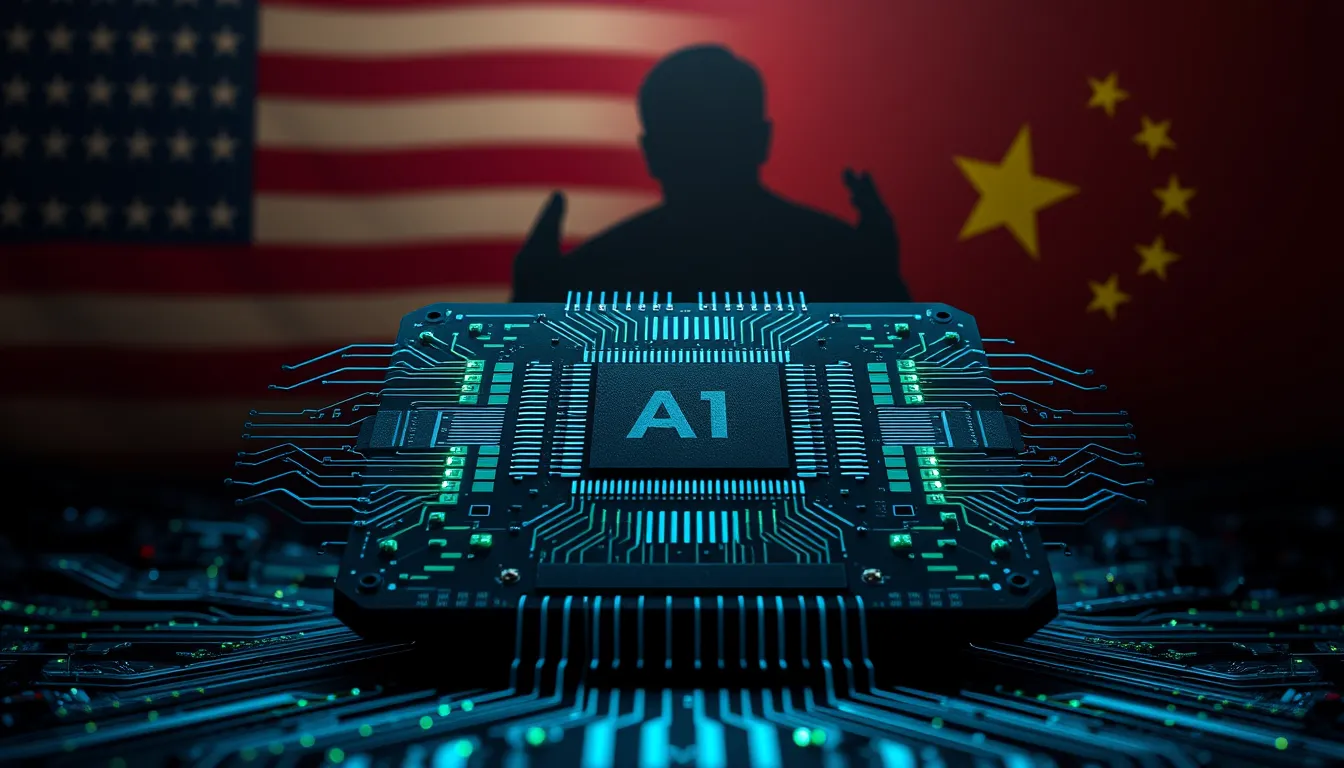Now Reading: Bold AI Export Controls: Biden’s Advanced Chip Strategy
-
01
Bold AI Export Controls: Biden’s Advanced Chip Strategy
Bold AI Export Controls: Biden’s Advanced Chip Strategy

Bold AI Export Controls: Biden’s Advanced Chip Strategy
Introduction to AI Export Controls
In a transformative shift for the global technology landscape, the Biden administration has implemented rigorous AI export controls that are already beginning to reshape the dynamics of international tech commerce. This bold policy is primarily focused on restricting the flow of advanced AI chips—one of the critical components that power modern artificial intelligence systems. By imposing these export restrictions, the administration seeks not only to protect national security but also to maintain strategic supremacy in an increasingly competitive global technological arena.
The driving force behind these measures is the recognition that advanced AI chips represent a significant part of the technological infrastructure fueling both commercial and military innovations. With artificial intelligence playing a vital role in industries ranging from healthcare and finance to cyber defense and autonomous vehicles, this policy shift underlines the urgent need to control who gains access to such sophisticated technologies. In essence, these controls are designed to prevent adversaries—most notably, state actors like China—from acquiring technology that could be used to undermine global stability or enhance their military capabilities.
Key Components of the New Policy
A closer examination of the new policy reveals several critical elements that distinguish it from previous export regulations. These components have been meticulously designed to serve both strategic interests and the practical demands of rapidly evolving technology. Here are some of the key aspects of the policy:
- Restriction on Advanced AI Chips: The new guidelines limit the export of state-of-the-art AI chips to nations beyond a select group of 18 allied countries, a list that includes strategic partners such as the UK, Japan, and the Netherlands. This measure is intended to create a barrier against nations whose technological ambitions could directly threaten U.S. national security.
- Limits on GPU Orders: In addition to the restrictions on advanced AI chips, the policy also imposes specific quotas and controls on GPU (Graphics Processing Unit) orders. This aspect of the policy is particularly relevant for academic and research institutions, where GPU resources are critical for the development of AI models and advanced research. By regulating these orders, the administration aims to ensure that these powerful computational tools are not misappropriated for purposes that might compromise national or global security.
These elements collectively underscore a strategic reorientation of U.S. export policy, where technological advantages are carefully guarded and selectively shared with trusted allies through controlled channels.
Biden Administration AI Policy and Global Impact
At the core of the Biden administration’s approach lies a commitment to enhancing national and global security through proactive policy measures. The recent export controls, deeply rooted in broader AI policy frameworks, serve as an important tool in the U.S. strategy to manage the complex interplay between technological innovation and international diplomacy.
Enhancing National Security
The rationale for these controls is clear: advanced AI chips are not mere products but are enablers of powerful technologies that can tip the balance in military and cyber domains. National security considerations thus necessitate rigorous oversight of technology dissemination. By limiting exports, the administration prevents adversarial nations from obtaining tools that could be used in cyber warfare, espionage, or other destabilizing activities. This move is a strategic response to emerging threats that are increasingly digital and intertwined with modern geopolitical rivalries.
Promoting Responsible Global AI Development
Beyond national security, the export controls aim to promote responsible global development of AI technologies. By imposing strict regulations on the flow of advanced chips, the U.S. is encouraging a model of international cooperation where technology transfers are contingent upon shared values and security standards. This approach is expected to foster collaboration among allied nations while simultaneously limiting the potential for technology misuse. Moreover, the policy is designed to exert pressure on nations that do not adhere to these standards, thereby acting as a deterrent against unethical practices in the tech industry.
Balancing Innovation with Control
The Biden administration’s policy also strikes a delicate balance by acknowledging the need to support domestic innovation while imposing controls on international technology transfer. On one hand, restricting exports of advanced AI chips preserves a competitive edge for American companies in the global market. On the other, it necessitates careful negotiations with domestic stakeholders, including industry leaders and academic institutions, to ensure that the restrictions do not inadvertently stifle innovation or impede research collaboration with trusted allies.
Industry Reactions and Long-Tail Considerations
The implementation of these AI export controls has elicited a varied response from within the technology industry. Leading manufacturers, notably Nvidia—a global leader in advanced AI chips—have expressed concerns regarding the potential economic impacts of these restrictions. The policy has raised several questions about revenue shifts, supply chain adjustments, and market competitiveness in the global AI ecosystem.
Concerns from Technology Leaders
Nvidia’s apprehensions center around the possibility that the restrictions could limit market opportunities, particularly in regions that have traditionally represented a significant share of the company’s export revenue. The tech giant has noted that while the policy aims to safeguard national interests, it could also lead to reduced sales volumes and increased operational costs for manufacturers who must now navigate a more fragmented market landscape.
Furthermore, there are concerns about the long-term impact on innovation. Some industry experts argue that by restricting access to cutting-edge AI chips, there is a risk of slowing down technological progress in research and development within the academic sector. This could have a ripple effect on the overall pace of scientific discovery and technology commercialization. However, proponents of the policy counter that these challenges are a necessary trade-off for mitigating risks related to technological proliferation in hostile markets.
Impact on China and Global Supply Chains
Another major dimension of this policy is its potential impact on China—a nation that has been aggressively pursuing advancements in artificial intelligence. The export controls are expected to constrain China’s ability to procure the most advanced AI chips, thereby impacting its efforts to become a dominant player in the global AI race. This measure is not merely a restriction but a strategic recalibration that is likely to alter how global supply chains for advanced technology operate in the coming years.
Trade analysts suggest that while China may seek to develop indigenous capabilities in chip manufacturing, the short-to-medium term implications could include slower growth in its AI sector and increased reliance on alternative markets for technology procurement. The policy thus both challenges and shapes the trajectory of global AI development by reinforcing the strategic divide between nations aligned with U.S. policies and those that remain outside this trusted network.
Academic and Research Implications
One of the more nuanced aspects of the export controls is their impact on academic and research communities. GPUs and advanced AI chips are cornerstone technologies in academic research, powering experiments and innovations across scientific disciplines. The imposition of strict export limits on these components is likely to force research institutions to recalibrate their procurement strategies and invest more heavily in domestic alternatives or allied sources.
This situation presents a dual challenge: ensuring that scientific progress continues unabated while maintaining strict controls over technology that could potentially be misused. Policymakers have indicated that future iterations of the regulation may include exemptions or special provisions for academic research, provided that such measures can be implemented without compromising security objectives. The dialogue between regulatory bodies and the academic community will be pivotal in striking the right balance.
Broader Implications and Future Outlook
The new AI export controls are more than just a regulatory adjustment—they are part of a broader effort to redefine global technology standards and international relations. As the tech landscape evolves, the interplay between technological innovation and national security becomes ever more significant. Several key trends and implications emerge from this policy shift:
Redefining Global Tech Standards
In an era where technological advancements can rapidly shift geopolitical power balances, the U.S. is positioning itself as a standard-bearer in the responsible governance of advanced technology. Through these export controls, the administration is effectively setting a benchmark for how sensitive technologies are distributed internationally. This move could encourage other nations to adopt similar standards, fostering an environment where global tech transfer is governed by a shared commitment to security and ethical practices.
Shaping Strategic Alliances
The selective export criteria—focusing on a trusted group of 18 allied countries—signals a clear intent to deepen strategic partnerships. By guaranteeing the flow of advanced AI chips to these allies, the U.S. strengthens its network of partners who share common security values and interests. This alignment not only benefits the collective defense posture but also facilitates coordinated responses to emerging global challenges, whether they be technological or geopolitical in nature.
Encouraging Domestic Innovation
From an economic perspective, the export controls could serve as another catalyst for domestic innovation. With restricted access to international markets, U.S.-based tech companies may find increased incentives to invest in local research and development. The resulting focus on innovation could drive breakthroughs in chip design, artificial intelligence processes, and other critical technology sectors, ultimately reinforcing national competitiveness in a global market.
Navigating a Fragmented Global Market
However, the policy also presents challenges, particularly in terms of managing a more fragmented global market. With countries outside the circle of trusted allies facing restrictions, there may be a surge in efforts to develop alternative technology ecosystems. This could lead to a bifurcation in global technology standards, where divergent regulatory regimes drive innovation along parallel paths. In such a scenario, international cooperation might become more complex, although it may also spur competition that accelerates advancements in AI and related fields.
Future Policy Developments
Looking ahead, it is likely that the current export controls will be only one facet of a more comprehensive strategy to manage the global flow of critical technologies. As new developments emerge and the implications of existing policies are better understood, policymakers may choose to adapt or expand the regulatory framework. Engaging with stakeholders—ranging from industry leaders and academic researchers to international partners—will be crucial in shaping future iterations that can deftly balance security concerns with the need for innovation.
Conclusion
In summary, the newly enacted AI export controls represent a pivotal shift in both U.S. national security policy and global technological governance. Biden’s advanced chip strategy not only seeks to safeguard American technological superiority but also aims to shape international norms governing critical high-tech exports. By restricting access to advanced AI chips and imposing stringent controls on GPU orders, the policy addresses both immediate security concerns and future challenges related to the global proliferation of cutting-edge technology.
The ripple effects of these measures are expected to influence diverse sectors—impacting major industry players such as Nvidia, challenging China’s ambitions in the high-tech domain, and redefining research protocols within academic institutions. Moreover, these regulations may pave the way for tighter international standards, stronger strategic alliances among trusted nations, and renewed focus on domestic innovation.
As the global landscape becomes increasingly defined by the interplay of technological advancement and geopolitical strategy, policies such as these will undoubtedly play a critical role. They signal a move toward a more secure and ethically governed future for advanced technologies—a future where the careful management of innovation and risk is paramount. The coming years will reveal the full extent of the impact of these export controls, but what remains clear is that the U.S. is taking decisive steps to shape the direction of global technology policy in an era marked by rapid change and heightened geopolitical tensions.
For readers interested in exploring this topic further, additional resources and analyses are available from leading industry experts, governmental reports, and academic publications. These insights provide a broader context for understanding not only the immediate implications of the export controls but also their long-term significance in an increasingly interconnected and competitive world.
Ultimately, Biden’s advanced chip strategy is a testament to the evolving nature of technology governance. It reflects a careful balancing act between fostering innovation and protecting national interests, and it sets the stage for a future where ethical considerations and strategic imperatives guide the global development of artificial intelligence. This pivotal policy is likely to serve as a benchmark for future regulations in the tech sector, influencing how nations interact, compete, and collaborate in the quest for technological advancement.

























